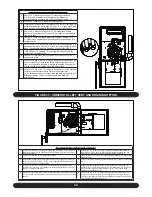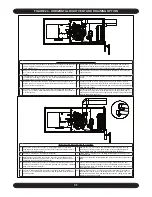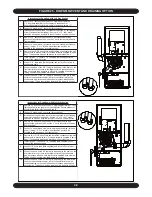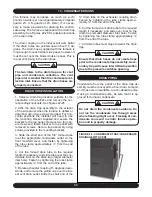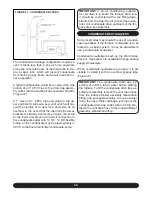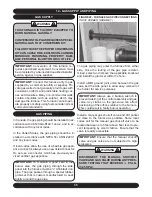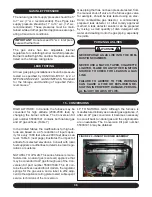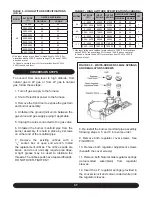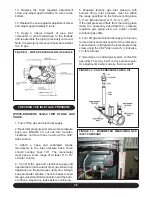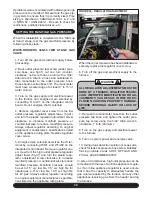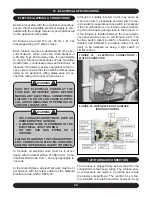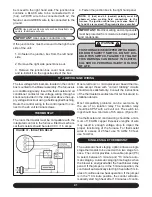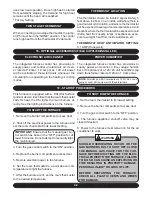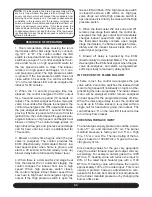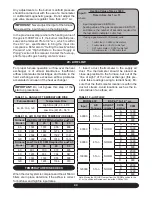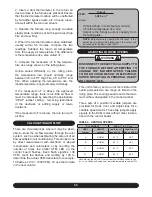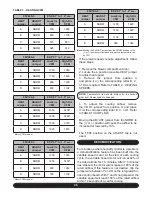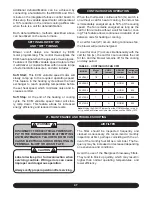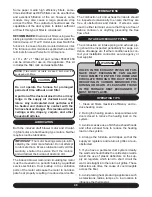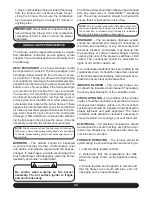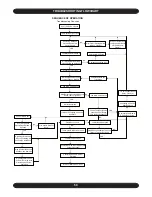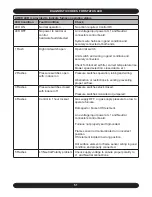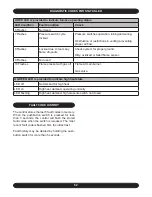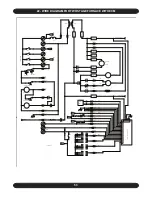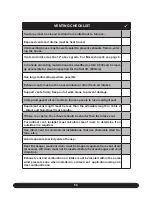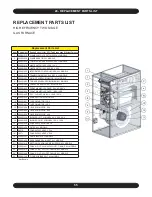
44
For proper furnace operation, air flow over the heat
exchanger is of utmost importance. Insufficient
airflow accelerates metal fatigue and failure in the
heat exchanger and excessive airflow promotes
accelerated corrosion of the heat exchanger.
IMPORTANT:
Do not bypass this step of the
start up procedures.
TEMPERATURE RISE CHECK
When the duct system is complete and the air filter or
filters are in place, determine if the airflow is correct
for both low and high fire input rates..
1. Insert a duct thermometer in the supply air
duct. The thermometer should be placed as
close as practical to the furnace, but out of the
“line of sight” of the heat exchanger (this pre-
vents false readings owing to radiant heat). En-
sure that the thermometer location is within the
duct air stream. Avoid locations such as the in-
side radius of an elbow, etc.
20 - AIR FLOW
Any adjustments to the burner manifold pressure
should be carried out with the use of a manometer
or calibrated magnehelic gauge. Do not adjust the
gas valve pressure regulator more than ±0.3” w.c.
IMPORTANT:
Never adjust the input of the furnace
to exceed the input shown on the rating plate.
In the previous example where the heating value of
the gas is 1100 BTU/cu. ft., the burner manifold pres-
sure can be reduced 3% to 3.4” w.c., which is within
the ±0.3” w.c. specification to bring the input into
compliance. Refer also to
“Setting the Gas Manifold
Pressure”
and
“High Altitude in the Gas Supply &
Piping”
section of this manual. Contact the fuel sup-
plier for specific gas heating content values.
Input =
Heating Value of Gas x 3600
Time in Sec. for 1 cu. ft.
where:
input is expressed in BTU/Hr
heating value of the gas is expressed in BTU/ft
3
and time is the number of seconds required for
the test dial to indicate 1 cubic foot.
•
•
•
If using a gas meter with SI (metric) units:
1 cubic foot = 0.0283 cubic meters
1 cubic meter = 35.315 cubic feet
0.01 cubic meter = 0.3531 cubic feet
0.5 cubic meter = 1.766 cubic feet
•
•
•
•
TABLE 1B - AIR FLOW FOR TEMPERATURE RISE
Furnace
Model
High Fire (HF) CFM Required for a ▲T of:
35
45
55
65
60
1501
1167
955
808
80
2001
1557
1274
1078
100
2502
1946
1592
1347
120
3002
2335
1910
1616
Furnace
Model
Low Fire (LF) CFM Required for a ▲T of:
25
35
45
55
60
901
700
573
485
80
1201
934
764
647
100
1501
1167
955
808
120
1801
1401
1146
970
TABLE 1A - RANGE OF TEMPERATURE RISE
Furnace Model
Temperature Rise
60, 80, 100, 120
High Fire (HF) 35 - 65°F
Low Fire (LF) 25 - 55°F
TABLE 10 - AIR FLOW
MODEL 95V
ESP 0.1” to 1.0” w.c.
Input
A/C
Tonnage
ADJUST
Jumper
COOL
Jumper
CFM
60000
3 Ton
NORM
A
1200
B
1000
C
800
D
600
80000
3 Ton
NORM
A
1200
B
1000
C
800
D
600
80000
4 Ton
NORM
A
1600
B
1200
C
1000
D
800
100000
5 Ton
NORM
A
2000
B
1600
C
1200
D
800
120000
5 Ton
NORM
A
2000
B
1600
C
1200
D
800
Note: Moving the ADJUST jumper from the NORM position to the
(+) or (-) position will increase or lower the CFM by 15%
Содержание G95V
Страница 27: ...27 FIGURE 21A DIRECT VENT TERMINAL CLEARANCES...
Страница 28: ...28 FIGURE 21B NON DIRECT VENT TERMINAL CLEARANCES...
Страница 53: ...53 22 WIRE DIAGRAM FOR TWO STAGE FURNACE WITH ECM...

